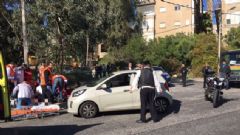Human Rights Voices
While the UN devotes its human rights operations to the demonization of the democratic state of Israel above all others and condemns the United States more often than the vast majority of non-democracies around the world, the voices of real victims around the world must be heard.
Palestinian Authority/Gaza, January 5, 2017
Israeli Killed in Terror Shooting Attacks in Haifa
Original source
Two separate shootings in Haifa on Tuesday, in which one person was killed and another injured, may have been part of the same terror attack, according to assessments by police who continued a manhunt for the perpetrator on Wednesday.
Yehiel Iluz, 48, a senior judge on a Haifa rabbinic court for conversion, was moderately wounded in the first shooting on the city's Haatzma'ut Road on Tuesday.
Some 30 minutes later, Guy Kafri, 47, a van driver from Haifa's Nesher neighborhood, was shot and killed on nearby Hagiborim Street.
First reports indicated a case of mistaken identity in a possible gangland shooting, but as the investigation went on, police increasingly began to suspect it was a terror attack. A gag order was placed on the investigation Tuesday and few details were made available to the press.
On Wednesday, police intensified a manhunt for a suspect, raiding an abandoned home in the predominantly Arab neighborhood of Halissa in Haifa and searching it for over three hours, according to Hebrew media reports.
The suspect lives in the neighborhood, according to reports.
Residents of Halissa called on the suspect, who has not been named, to turn himself in as they braced for increased police presence in the area.
One resident told Ynet: "We wouldn't like to see the incident with Nashat Milhem happen again," in reference to the nationwide police manhunt in January 2016 for the terrorist who carried out a shooting attack on Dizengoff street in Tel Aviv on January 1 that year, killing two people, and later murdering a taxi driver who had unsuspectingly picked him up. The police hunt had paralyzed the country for days after the attack. Milhem died in a shootout with police in his hometown of Ar'ara in Israel's Wadi Ara area a week after the killings.
"It's very scary to see armed, masked police going into homes [looking for the suspect]. It's like in a war; it's better that he turn himself in, lest he endanger the whole neighborhood," the woman said.
Rafat Asadi, a lawyer who lives in the neighborhood, told Ynet that he was surprised by the identity of the suspect, "an honors student" who comes from a "completely normal family, an exemplary family, that has had no run-ins with the law."
"If he's involved, I call on him in the name of the whole neighborhood to turn himself in," said Asadi, describing the late-night raids on the suspect's home and other homes in the area "and from which the neighbors suffer."
Early reports on Tuesday identified Kafri as a rabbi linked to a rabbinical court and hinted at a connection between the two attacks. A spokesperson for the rabbinic court told religious news site Kikar Hashabat earlier on Tuesday that it appears to be a case of mistaken identity and that the driver and the judge were victims of an underworld battle.
Shahar Dror, Kafri's brother-in-law, said his Kafri had no criminal record or personal enemies.
"He was a good man who helped everyone," Dror told Channel 2. "We don't understand what happened and hope the police get to the truth and we find out who stands behind Guy's murder. He had no enemies."
Israeli media reported that eyewitnesses to the second attack said the shooter was a woman.
Iluz, a father of seven, lives in Galilee town of Migdal Ha'emek, Channel 10 reported. He works one day a week in Haifa.
A spate of stabbings, car-rammings and shooting attacks by mainly Palestinian assailants that began a year ago has waned over the last six months, though sporadic incidents have persisted. Some of the attackers, like Milhem, were Arab Israelis. From October 2015 to October 2016, 36 Israelis, two Americans and an Eritrean national were killed in in the attacks.
According to AFP figures, some 238 Palestinians, a Jordanian and a Sudanese migrant were also killed during the violent spurt, most of them in the course of carrying out attacks, Israel says, and many of the others in clashes with troops in the West Bank and at the Gaza border, as well as in Israeli airstrikes in the Strip.

